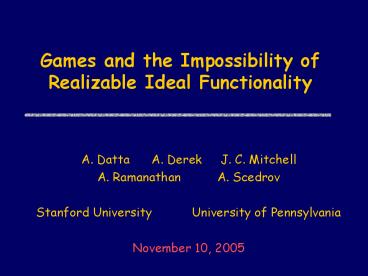Games and the Impossibility of Realizable Ideal Functionality - PowerPoint PPT Presentation
Title:
Games and the Impossibility of Realizable Ideal Functionality
Description:
Games and the Impossibility of Realizable Ideal Functionality. A. Datta A. Derek J. C. Mitchell ... Impossibility Theorem ... Impossibility Theorem. What is an ' ... – PowerPoint PPT presentation
Number of Views:44
Avg rating:3.0/5.0
Title: Games and the Impossibility of Realizable Ideal Functionality
1
Games and the Impossibility of Realizable Ideal
Functionality
- A. Datta A. Derek J. C. Mitchell
- A. Ramanathan A. Scedrov
- Stanford University University of
Pennsylvania - November 10, 2005
2
The Problem
- Specifying security of cryptographic primitives
and protocols - Games GM84
- Between challenger and adversary
- Defines specific moves for each player
- Not composable
- Example IND-CPA, IND-CCA for encryption
- Universal Composability Can01, PW01
- Simulation relation between real protocol and
ideal functionality, which is secure by
construction - Composable (Main advantage)
- Example SMT using trusted third party
- How are these specification methods related?
3
Impossibility Theorem
- If F is any ideal functionality for
bit-commitment, then no real protocol UC-securely
realizes F - Intuition Can construct information-
theoretically hiding and binding protocol for BC
that does not use TTP - Similarly, symmetric encryption, group
signatures, - Implication of theorem
- Develop other composable notions of security
- Conditional composability as opposed to universal
4
Outline
- Background
- Game-based specification
- UC-based specification
- Formalism PPC
- Contribution of this work
- Definition of Ideal Functionality
- Connects UC with games
- Impossibility Theorem
5
Games for bit-commitment
Challenger
Attacker
Challenger
Attacker
Commit(b)
Commit(b)
b
Open(1-b)
Attacker wins if b b
Attacker wins if she can produce 2nd message
Hiding Game
Binding Game
6
Functionalities (UC)
- Will use UC (Canetti). Similar idea used in
Pfitzmann-Waidner - Two worlds Real protocol P and Ideal
functionality F - Require
- For every adversary A1 for P, there exists an
adversary A2 for F revealing same information in
any environment E
?
E
E
io
io
io
io
net
net
?
?
P
A
S
F
?
7
UC Bit-commitment specification
Environment E
b
I Commit
Open b
I
R
Commit b
I Commit
Open b
Simulator S
Open b
I,RCommit
Ideal F
Open b
8
PPC (MMS98, LMMS98, LMMS99, MMS03, RMST04, etc.)
- Process Algebra
- Convenient for expressing both games and
functionalities DKMRS04,DKMR05 in the same
language - Probabilistic computation model
- Provides bit-level representations of secrets
- Can express any poly-time (in security parameter)
computation or adversary
Described in previous reviews used in this work
9
Publications/Collaboration
- LMMS98 Penn-SRI-Stanford
- MRST04 Penn-Stanford
- DKMRS04 SRI-Stanford
- DDMRS05 Penn-Stanford
10
Outline
- Background
- Game-based specification
- UC-based specification
- Formalism PPC
- Contribution of this work
- Definition of Ideal Functionality
- Connects UC with games
- Impossibility Theorem
11
What is an ideal functionality
- Proposal Ideal functionality for a primitive
should satisfy corresponding game-conditions
information-theoretically - Intuition secure by construction
- Example Bit-commitment two games for hiding
and binding properties
12
Issue
- Standard game-based definitions are given for
non-interactive algorithms - Encryption has KeyGen, Encrypt, Decrypt
- We allow protocols
- Need a mechanism to call an implementation of a
protocol - Solution Call and return interface
13
Call and Return
- Principal sends a message with all params on a
dedicated private channel - Implementation listens on private channel and
conducts protocol. - Implementation returns values to principal
- out(impl,ltparamsgt).in(impl,ltreturn valsgt)
- Implementation(impl)
14
2-Party Bit-Commitment (Game)
- 4 protocols
- SendCommit(b,C) returns s
- GetCommit(C) returns s
- Open (s,C) returns e
- Verify(s,C) returns 0,1,
- 3 properties
- Correctness
- Hiding
- Binding
15
2-Party Bit-Commitment (Games)
- Hiding
- SendCommit(b,C) returns s.in(c,b).out(c,yes if
b b) - ?
- SendCommit(b,C) returns s.in(c,b).out(c,yes
0.5 of the time) - Binding
- GetCommit(C) returns s.new(b).out(b).Verify(s,C)
returns r. - out(c,yes if r b)
- ?
- GetCommit(C) returns s.new(b).out(b).Verify(s,
C) returns r. - out(c,if r then no else yes 0.5 of
the time) - Correctness
16
Ideal Functionality for BC
- Any implementation of the calling interface
that satisfies the games - INFORMATION THEORETICALLY
- Intuition Secure by construction
- (may use unrealistic mechanism like TTP, secure
and authenticated channels)
17
Impossibility Theorem
- If F is any ideal functionality for
bit-commitment, then no real protocol UC-securely
realizes F - Proof idea Can construct information-
theoretically hiding and binding protocol for BC
that does not use TTP
18
Proof Phase 1
19
Proof Phase 2
20
Payoff
- So Q and S and F together constitute a real
implementation for BC that is - Info-theoretically binding
- Info-theoretically hiding
- Correct
21
Reductions
- Can show that any property that gives BC cant
be realized - Uses reductions
22
Other things you cant do
- Variant of Symmetric encryption
- Semantic security and Ciphertext integrity
- Variant of Group signatures
- Anonymity and Traceability (strong variant)
23
Related work
- Bit-commitment
- For a particular F, no protocol securely realizes
F CF2001 - Allows Canetti to reason about what the simulator
must do - Shows that simulator does not have enough info.
to simulate - Zero-knowledge, secure function evaluation,
oblivious transfer - Similar results
24
Conclusions and Future Work
- UC-security cannot be achieved for important
cryptographic tools - Need for alternative approaches to compositional
security - More general versions of ideal functionalities
- Modification of UC framework
- Conditional composability instead of universal
composability
25
Questions?































